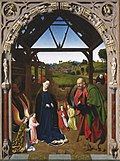Wikipedia:Today's featured article/December 25, 2014
The Nativity is a large oil-on-wood panel painting by the Early Netherlandish artist Petrus Christus, completed between the early 1440s and early 1460s. It shows a nativity scene bordered with grisaille (monochrome) archways and faux sculpted reliefs. Christus was influenced by the first generation of Netherlandish artists, especially Jan van Eyck and Rogier van der Weyden, and in its sense of grace, simplicity and naturalism, the devotional panel is characteristic of art of that period. The unusually large panel – perhaps painted as a central altarpiece panel for a triptych – is nuanced and visually complex. It reflects the 14th-century Devotio Moderna movement and contains complex Christian iconography, juxtaposing Old and New Testament saints and figures with great subtlety. The sculpted archway reliefs depict Old Testament ideas of sin and punishment, signaling the advent of Christ's sacrifice. The composition employs geometric forms and a bold use of color. In the 1930s, Andrew Mellon bequeathed it to the National Gallery of Art in Washington, as one of several hundreds of works donated from his personal collection. It was restored in the early 1990s. (Full article...)
Recently featured: American paddlefish – 1995 Pacific hurricane season – Colin Hannah

